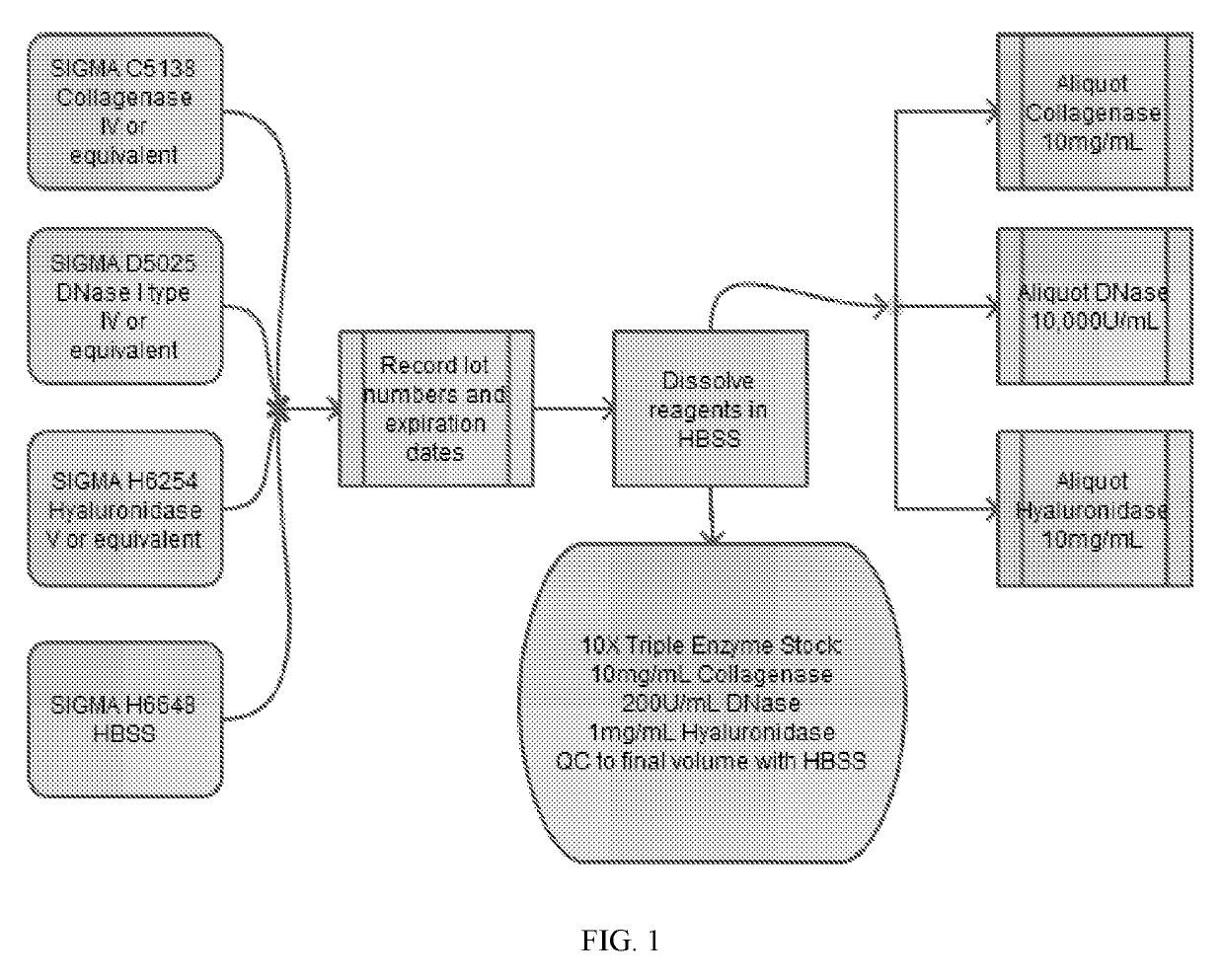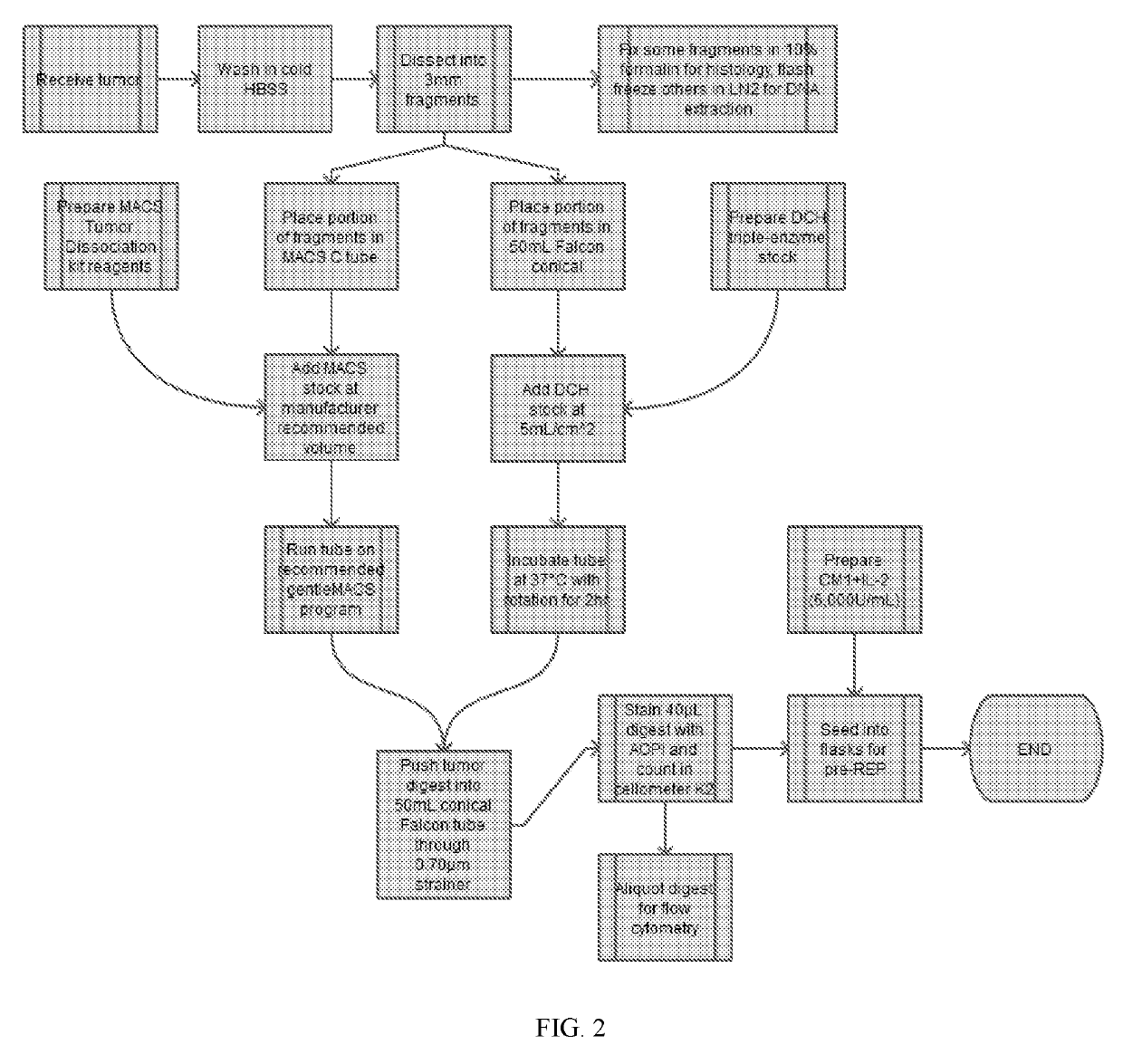Remnant Tumor Infiltrating Lymphocytes and Methods of Preparing and Using the Same
a technology of infiltrating lymphocytes and remnant tumors, which is applied in the field of preparing and using the same, can solve the problems of reducing the ability to obtain til than from pre-rep initiation processes with il-2, increasing the duration, complexity, and cost of performing til therapy, and increasing the complexity of the process
- Summary
- Abstract
- Description
- Claims
- Application Information
AI Technical Summary
Benefits of technology
Problems solved by technology
Method used
Image
Examples
example 1
of rTILs from Tumor Digests
[0717]Tumor remnants were digested according to the following exemplary procedure. This procedure describes the digestion of a fresh human tumor sample into a viable, single-cell suspension, to obtain and isolate tumor-infiltrating lymphocytes, and may use DNase-Collagenase-Hyaluronidase (DCH) methods (as described herein) or MACS human tumor dissociation kit (TDK) (Miltenyi Biotech, Inc., San Diego, Calif., USA) digestion protocols for the dissociation of human tumors.
[0718]Preparation of the CM1+IL-2 working culture medium is as follows. Place 500 mL RPMI 1640, 200 mM L-glutamine, and 100 mL human AB serum in a water bath at 37° C. to equilibrate for at least 30 minutes. Transfer the contents of this mixture from the water bath to a biosafety cabinet along with 1000×β-ME stock and 50 mg / mL gentamicin stock solution from the refrigerator. Remove 50 mL from the RPMI 1640, add: 50 mL human AB serum, 5 mL 200 mM L-glutamine, 500 μL 1000×β-ME, and 500 μL 50 m...
example 2
c Characterization of rTILs from Tumor Digests
[0725]During the pre-REP, tumor-resident TILs emigrate as eTILs and proliferate. The length of the pre-REP used to prepare eTILs for comparison with rTILs may vary between 11-21 days, depending on cell growth. Residual tumor fragments (remnants) are normally discarded and the expanded eTIL are subjected to a REP with irradiated PBMC feeders, anti-CD3 and IL-2. Viable TILs remaining in the tumor remnants (rTILs) following the pre-REP were investigated after digestion according to Example 1 as described above to assess their function and phenotype in comparison to eTILs.
[0726]Cell populations from the tumor remnants and pre-REP suspension (i.e., the expanded cell population) in melanoma, head and neck, breast, renal, pancreatic, lung and colorectal tumors (n=17) were evaluated and compared. Interestingly, rTILs are consistently phenotypically distinct from eTILs, as determined herein and shown by differential expression of various markers ...
example 3
l Characterization of rTILs from Tumor Digests
[0731]T cell dysfunction is directly associated with a loss of mitochondrial function. Sharping, et al., Immunity 2016, 45, 374-88. Moreover, the reprogramming of T cells to favor mitochondrial biogenesis can increase intratumoral T cell persistence and function. Therefore, more metabolically active T cells are pivotal in mounting an efficient immune response to tumor. In an effort to assess the eTIL and rTIL functionally, eTIL and rTIL were compared in terms of metabolic capacity via Mitotracker and 2-(N-(7-nitrobenz-2-oxa-1,3-diazol-4-yl)amino)-2-deoxyglucose (2-NBDG). 2-NBDG may be used to measure glucose uptake, but does not specify the primary metabolic process; i.e., full oxidation in the mitochondria or only glycolysis and generation of lactate. Mitotracker dye (ThermoFisher Scientific, Inc., Waltham, Mass., USA) may be used to measure mitochondrial mass. Comparison of the eTIL and rTIL by this approach demonstrated an enhancement...
PUM
| Property | Measurement | Unit |
|---|---|---|
| Fraction | aaaaa | aaaaa |
| Fraction | aaaaa | aaaaa |
| Time | aaaaa | aaaaa |
Abstract
Description
Claims
Application Information
 Login to View More
Login to View More - R&D
- Intellectual Property
- Life Sciences
- Materials
- Tech Scout
- Unparalleled Data Quality
- Higher Quality Content
- 60% Fewer Hallucinations
Browse by: Latest US Patents, China's latest patents, Technical Efficacy Thesaurus, Application Domain, Technology Topic, Popular Technical Reports.
© 2025 PatSnap. All rights reserved.Legal|Privacy policy|Modern Slavery Act Transparency Statement|Sitemap|About US| Contact US: help@patsnap.com



